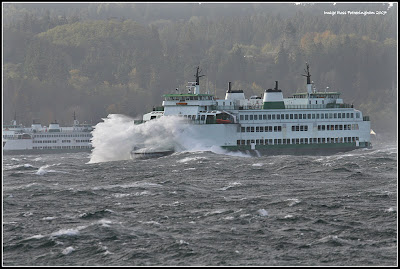Seattle was once no more than a muddy little port, transferring timber, coal, grain, and fish to rail cars and barges.
Although logging, lumbering, and the fishing industry still remain important to Seattle, environmental concerns and declining fisheries have shifted the region’s emphasis away from industries based on natural resources.
Today the city is a major manufacturing center and a prime air and water port for international trade. 
Situated on Elliott Bay, a deep and unobstructed saltwater harbor, Seattle’s port was organized in 1911 and is publicly owned. Seattle boasts the shortest routes from the U.S. mainland to Tokyo, Japan, and is the primary American port to Asia and Siberia. The port has also long considered itself the gateway to Alaska. Seattle’s port is among the largest in the United States, managing 28 commercial terminals that link 30 steamship operators with more than 150 truck, rail, or warehouse operators.
Once a one-company town, dependent on the fortunes of The Boeing Company, Seattle’s economy in the 1990s was characterized by industrial diversity, including aerospace, software, computer and electronic equipment, medical devices and biotechnology, and telecommunications products.
Among Greater Seattle’s leading employers are Boeing and the Microsoft Corporation. Other major local companies include Costco Companies, the Weyerhaeuser Company, Paccar, Nordstrom, SAFECO Corporation, Airborne, Starbucks Coffee, Amazon.com, Inc., and Alaska Airlines. ( Seattle - Tacoma International Airport )
( Seattle - Tacoma International Airport )
Seattle is served by the Seattle-Tacoma International Airport, 21 km (13 mi) south of the city. The Burlington Northern and Union Pacific railroads provide transcontinental service to Seattle, and Amtrak offers passenger rail service.
The Metro Transit bus system provides service throughout King County, linking to Pierce County Transit and Snohomish County Transit, as well as to waterfront ferries.  ( Ferries )
( Ferries )
The Washington State Ferry system provides service from Seattle to Bainbridge Island, Vashon Island, and Bremerton, Kingston, and Southworth on the Kitsap Peninsula.
In 1996 voters in Pierce, King, and Snohomish counties approved the Regional Transit Authority. This plan proposed to link Seattle with its northern neighbor Everett and southern neighbor Tacoma by a fleet of express buses and a network of high-speed commuter trains.
Dubbed Sound Transit, the RTA pleased residents by choosing Seattle’s historic Union Station in the International District as headquarters for the new transit system.
Saturday, March 1, 2008
Economy of Seattle
Posted by Star Light at 2:06 AM
Subscribe to:
Post Comments (Atom)
0 comments:
Post a Comment